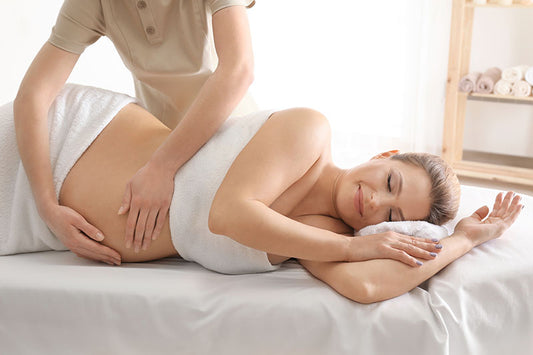Collection: During & After Pregnancy: Prenatal & Postpartum Massage Therapy
-
Postpartum Massage - 90 Minutes By Jennifer Heideman, LMT
Vendor:Jennifer Heideman, LMT #24576Regular price $175.00Regular priceUnit price / per -
Prenatal Massage - 90 Minutes By Jennifer Heideman, LMT
Vendor:Jennifer Heideman, LMT #24576Regular price $175.00Regular priceUnit price / per -
Postpartum Massage - 60 Minutes By Jennifer Heideman, LMT
Vendor:Jennifer Heideman, LMT #24576Regular price $120.00Regular priceUnit price / per -
Prenatal Massage - 60 Minutes By Jennifer Heideman, LMT
Vendor:Jennifer Heideman, LMT #24576Regular price $120.00Regular priceUnit price / per
Massage During Pregnancy: Prenatal & Postpartum
Massage During Pregnancy: An In-Depth Exploration
Introduction
Prenatal and postpartum massage are both specialized forms of therapeutic bodywork designed to support the physiological, structural, and emotional well-being of both the expectant and new mother. Tailored to address the unique needs of women during and after pregnancy, this massage modality helps alleviate common discomforts, promotes relaxation, and supports overall maternal health.
Historical Background
Massage therapy has been used for centuries across various cultures to support pregnant women. Traditional practices in many societies incorporated massage techniques to ease the physical burdens of pregnancy and childbirth. In the modern era, pregnancy massage has evolved with a greater understanding of anatomy and physiology, alongside advancements in therapeutic techniques. Today, it is recognized as a safe and effective complementary therapy during pregnancy and the postpartum period.
Anatomy and Physiology of Pregnancy
Pregnancy induces significant changes in a woman's body, affecting multiple systems:
- Musculoskeletal System: The growing fetus increases the load on the musculoskeletal system, often leading to lower back pain, pelvic discomfort, and changes in posture due to the shifting center of gravity.
- Circulatory System: Blood volume increases significantly to support the growing fetus, which can cause swelling (edema), particularly in the lower extremities.
- Endocrine System: Hormonal changes, including increased levels of relaxin, progesterone, and estrogen, cause ligaments to soften and joints to become more flexible, preparing the body for childbirth but also increasing the risk of strain.
- Nervous System: The physiological and emotional stresses of pregnancy can affect the nervous system, leading to anxiety, sleep disturbances, and overall stress.
Mechanism of Massage During Pregnancy
Massage for expectant mothers involves techniques adapted to the needs of pregnant and postpartum women, ensuring comfort and safety. Key aspects include:
- Positioning: Proper positioning is crucial to ensure the safety and comfort of both the mother and baby. Sideline positioning with supportive pillows is commonly used to avoid pressure on the abdomen and maintain proper spinal alignment.
- Techniques: Gentle Swedish massage techniques are typically employed, including long strokes, kneading, and light tapping. Deeper techniques can be used cautiously and only on specific areas to avoid overstimulation of sensitive pressure points.
- Pressure Points: Therapists avoid pressure points that are believed to stimulate uterine contractions, such as those on the wrists, ankles, and lower back, particularly during early pregnancy.
Clinical Benefits
Massage during pregnancy offers a range of benefits for expectant and new mothers:
- Pain Relief: Reduces lower back, hip, and leg pain by addressing muscle tension and improving posture.
- Reduced Swelling: Enhances blood and lymph circulation, helping to reduce edema.
- Stress Reduction: Lowers cortisol levels and promotes relaxation, aiding in the management of stress and anxiety.
- Improved Sleep: Promotes better sleep by relaxing tense muscles and reducing discomfort.
- Enhanced Mood: Releases endorphins, which can improve mood and alleviate symptoms of depression.
Indications and Contraindications
Indications
Beneficial for a variety of common pregnancy-related issues, including:
- Lower back pain
- Sciatica
- Leg cramps
- Edema
- Headaches
- Stress and anxiety
- Insomnia
Contraindications
While generally safe, massage should be avoided or modified during pregnancy in certain conditions:
- High-risk pregnancy
- Pre-eclampsia or eclampsia
- Severe swelling
- Recent bleeding or spotting
- Deep vein thrombosis (DVT)
- Placenta previa or abruption
- Uncontrolled high blood pressure
Techniques and Approaches
Several specific techniques and approaches are used in pregnancy massage:
- Sideline Positioning: Utilizes pillows to support the body, maintaining spinal alignment and comfort.
- Swedish Massage: Employs gentle, flowing strokes to promote relaxation and improve circulation.
- Lymphatic Drainage: Uses light pressure to enhance lymphatic flow and reduce swelling.
- Myofascial Release: Gently addresses fascial restrictions that contribute to discomfort.
- Postpartum Techniques: Focuses on restoring muscle tone and addressing tension from breastfeeding and carrying the baby.
Evidence-Based Research
Research on pregnancy-related massage has demonstrated its efficacy in improving maternal health. A study published in the Journal of Psychosomatic Obstetrics & Gynecology in 2012 found that women receiving regular prenatal massage experienced reduced anxiety, improved mood, better sleep, and less back pain. Another study in the Journal of Bodywork and Movement Therapies in 2010 highlighted the benefits of postpartum massage, showing significant improvements in pain relief and emotional well-being.
Conclusion
Massage is a valuable therapeutic tool for supporting women through the transformative stages of pregnancy and postpartum recovery. By addressing the unique physical and emotional needs of expectant and new mothers, this specialized form of massage can significantly enhance maternal health and well-being.
For women experiencing the joys and challenges of pregnancy and early motherhood, prenatal and postpartum massage both provide a safe and effective means of promoting comfort, reducing stress, and fostering a positive pregnancy and postpartum experience. As research continues to validate its benefits, massage will remain an integral part of holistic maternal care.






